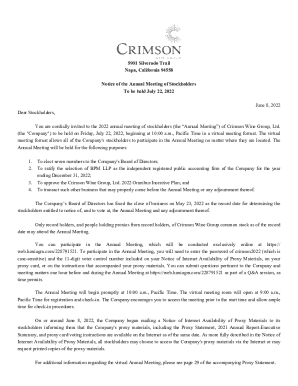Analyzing Proxy Statements (Form DEF 14A): A Step-by-Step Guide

Table of Contents
Understanding the Structure of a Proxy Statement (Form DEF 14A)
The DEF 14A, or proxy statement, follows a standardized format prescribed by the Securities and Exchange Commission (SEC) to ensure consistency and transparency. Knowing the typical sections and their purpose is the first step towards effective analysis. The format and information included can vary depending on the company and the specific matters being voted on, but key sections consistently appear:
- Executive Summary: This provides a concise overview of the key proposals to be voted on at the shareholder meeting. It's a great starting point for getting a quick grasp of the main issues.
- Voting Information: This crucial section explains how shareholders can exercise their voting rights – whether by mail, online, or through a proxy. Understanding the voting procedures is essential for participating in corporate decision-making.
- Board of Directors: This section profiles the current board members and nominees for election. Pay attention to their backgrounds, expertise, and any potential conflicts of interest. Analyzing board composition is a key element of corporate governance analysis.
- Executive Compensation: This section details the compensation packages of executive officers, including salaries, bonuses, stock options, and other benefits. This is a critical area for assessing executive pay practices and aligning incentives with shareholder value.
- Shareholder Proposals: Shareholders often submit proposals on various matters, which are included here. Examining these proposals provides insight into the concerns of significant stakeholders. Analyzing the voting results on these proposals provides additional context into corporate governance practices.
- Mergers and Acquisitions: If a merger or acquisition is proposed, detailed information about the transaction will be disclosed within the proxy statement. This section requires careful scrutiny to understand the implications for shareholders.
- Auditor Report: The independent auditor's report provides an assessment of the company's financial statements. Review this report to understand the auditor's opinion and any qualifications or concerns raised.
Key Metrics and Data to Analyze Within a Proxy Statement
Analyzing a proxy statement involves more than just reading; it requires identifying and evaluating key metrics and data points. A focused approach is essential to extract meaningful insights:
- Executive Compensation Analysis: Scrutinize the CEO-to-worker pay ratio, total compensation packages, and the structure of performance-based incentives. Are executive compensation levels aligned with company performance? Are incentives appropriately designed to drive long-term value creation?
- Corporate Governance Analysis: Examine the board's composition, independence (percentage of independent directors), and the effectiveness of its committees (audit, compensation, nominating and governance). A strong, independent board is a hallmark of good corporate governance.
- Shareholder Proposal Analysis: Evaluate the merits and implications of shareholder proposals and examine the voting results. Understand the rationale behind proposals and assess the company's response. This analysis indicates the responsiveness of the board to stakeholder concerns.
- Financial Highlights: Review key financial metrics and trends presented (though detailed financial statements are typically found elsewhere), paying attention to revenue growth, profitability, and debt levels. This allows for an assessment of the company’s financial health.
- Mergers and Acquisitions Analysis: If a merger or acquisition is proposed, carefully analyze the terms and conditions, including the exchange ratio, valuation, and potential synergies. This is crucial for understanding the strategic implications and potential impact on shareholder value.
Utilizing Proxy Statements for Investment Decisions
Analyzing proxy statements isn't just an academic exercise; it's a powerful tool for making sound investment decisions:
- Assessing Management Quality: Executive compensation and corporate governance analysis provides a window into the effectiveness and alignment of management. This can signal management's priorities and competence.
- Identifying Potential Risks: A thorough review of shareholder proposals and financial highlights can reveal potential risks, such as significant environmental concerns, weak internal controls, or unsustainable business practices.
- Formulating Your Voting Strategy: Armed with the information gleaned from the proxy statement, investors can make informed decisions on how to vote their shares, maximizing their influence on the direction of the company. Informed proxy voting is a powerful tool for shareholder engagement.
Tools and Resources for Analyzing Proxy Statements
Accessing and analyzing proxy statements efficiently requires the right tools and resources:
- SEC EDGAR Database: The SEC's Electronic Data Gathering, Analysis, and Retrieval (EDGAR) system is the primary source for accessing all SEC filings, including proxy statements (Form DEF 14A).
- Commercial Proxy Voting Services: Several commercial services provide analysis and recommendations on proxy votes, saving investors time and offering expert insights.
- Financial Data Providers: Bloomberg Terminal, Refinitiv Eikon, and FactSet are examples of financial data providers that offer comprehensive financial data, including proxy statement information and analytics. These tools streamline the process.
Conclusion
Mastering the art of analyzing proxy statements (Form DEF 14A) is essential for any serious investor. By understanding the structure, identifying key metrics, and utilizing the right tools, you can unlock valuable insights into a company's operations, corporate governance, and financial health. Unlock the value of DEF 14A filings and become a more informed investor by analyzing proxy statements today! Start utilizing this powerful resource to make more informed investment decisions and actively participate in corporate governance.

Featured Posts
-
 Changes To Reddits Upvote System Targeting Violent Content
May 17, 2025
Changes To Reddits Upvote System Targeting Violent Content
May 17, 2025 -
 Putin Dhe Presidenti I Emirateve Te Bashkuara Arabe Biseduan Cfare U Diskutua
May 17, 2025
Putin Dhe Presidenti I Emirateve Te Bashkuara Arabe Biseduan Cfare U Diskutua
May 17, 2025 -
 Celtics Cavaliers Prediction Can Boston Even The Series
May 17, 2025
Celtics Cavaliers Prediction Can Boston Even The Series
May 17, 2025 -
 Will The Knicks Beat The Pistons Prediction And Betting Tips For Msg Game
May 17, 2025
Will The Knicks Beat The Pistons Prediction And Betting Tips For Msg Game
May 17, 2025 -
 Delinquent Student Loans The Governments Aggressive Pursuit And Your Rights
May 17, 2025
Delinquent Student Loans The Governments Aggressive Pursuit And Your Rights
May 17, 2025
